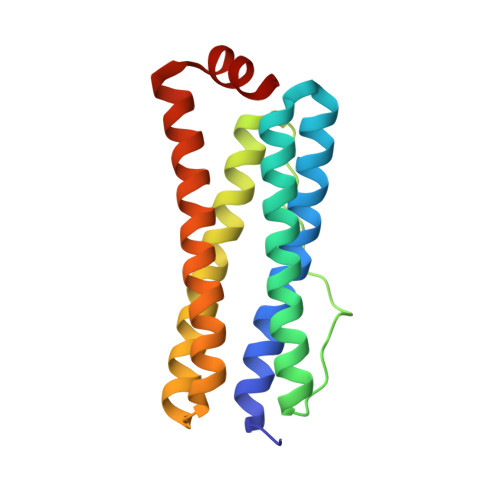Redox-Dependent Structural Changes in the Azotobacter vinelandii Bacterioferritin: New Insights into the Ferroxidase and Iron Transport Mechanism(,).
Swartz, L., Kuchinskas, M., Li, H., Poulos, T.L., Lanzilotta, W.N.(2006) Biochemistry 45: 4421-4428
- PubMed: 16584178
- DOI: https://doi.org/10.1021/bi060146w
- Primary Citation of Related Structures:
2FKZ, 2FL0 - PubMed Abstract:
In this work, we report the X-ray crystal structure of the aerobically isolated (oxidized) and the anaerobic dithionite-reduced (at pH 8.0) forms of the native Azotobacter vinelandii bacterioferritin to 2.7 and 2.0 A resolution, respectively. Iron K-edge multiple anomalous dispersion (MAD) experiments unequivocally identified the presence of three independent iron-containing sites within the protein structure. Specifically, a dinuclear (ferroxidase) site, a b-type heme site, and the binding of a single iron atom at the four-fold molecular axis of the protein shell were observed. In addition to the novel observation of iron at the four-fold pore, these data also reveal that the oxidized form of the protein has a symmetrical ferroxidase site containing two five-coordinate iron atoms. Each iron atom is ligated by four carboxylate oxygen atoms and a single histidyl nitrogen atom. A single water molecule is found within hydrogen bonding distance of the ferroxidase site that bridges the two iron atoms on the side opposite the histidine ligands. Chemical reduction of the protein under anaerobic conditions results in an increase in the average Fe-Fe distance in the ferroxidase site from approximately 3.5 to approximately 4.0 A and the loss of one of the ligands, H130. In addition, there is significant movement of the bridging water molecule and several other amino acid side chains in the vicinity of the ferroxidase site and along the D helix to the three-fold symmetry axis. In contrast to previous work, the higher-resolution data for the dithionite-reduced structure suggest that the heme may be bound in multiple conformations. Taken together, these data allow a molecular movie of the ferroxidase gating mechanism to be developed and provide further insight into the iron uptake and/or release and mineralization mechanism of bacterioferritins in general.
- Department of Molecular Biology and Biochemistry, University of California, Irvine, California 92697, USA.
Organizational Affiliation:



















